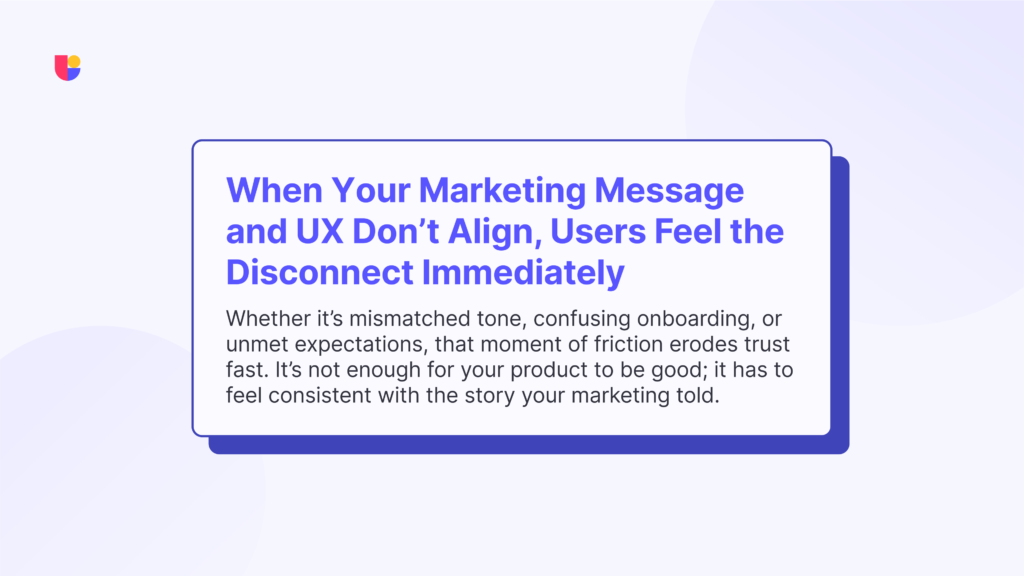As someone in marketing, I used to focus mostly on what happened before users clicked. We’d obsess over landing page CTAs, ad copy, open rates, and bounce rates. But what I’ve realized over time (coincidentally after I started working at Useberry), working alongside UX designers and researchers, is that the journey doesn’t stop at the click. In fact, that’s where the real “experience” begins.
When the tone, message, or expectations set by your marketing don’t match the product experience, users notice. That gap can mean the difference between a smooth onboarding or a quick bounce.
When Messaging and UX Don’t Match, Users Feel It (and Bounce Fast)
Ever clicked on an ad that promised one thing, only to land on a product that felt completely different? That jarring moment, where expectation meets reality, is often the result of marketing and product (or UX) not speaking the same language.
Here is what that disconnect looks like:
- A landing page says “Get insights instantly” but the product onboarding takes an hour.
- An email campaign sets a playful tone, but the product UI is stiff and corporate.
- A CTA says “Start designing” but drops you into a unintuitive dashboard with zero guidance.
Each of these creates friction. Not because the product is bad, but because the promise and the experience weren’t aligned. Users don’t separate “marketing” from “product.” It’s all one experience to them. If the expectations you set doesn’t match the reality, your brand’s credibility takes a hit and your products lose their trustworthiness.

No Guesses, No Hunches: Test it to Reveal Gaps in Your Messaging
At Useberry, we have seen how teams use our tools not just to test design decisions, but to make sure the messaging and UX actually make sense together. The handoff between marketing and product is where a lot of trust is built(or lost).
Here are a few ways to test your customer journey:
1. Landing Page Usability Testing
Before you launch a campaign, use Useberry to run a quick usability test on your landing page. Can users understand what’s being offered? Do they know what happens next? Ask some follow-up questions after your tasks or pair this with an Open Analytics test to see how they actually navigate to complete their tasks. You will often find moments of hesitation or confusion you didn’t expect.
2. Test the handoff between campaign and product
If your ad or email points to a specific feature or value, test that part of your product directly. Are users confused when they arrive? Are the instructions clear? This is where unmoderated tests can shine but remember to ask your participants to think out load! You’ll catch those small but critical moments of disconnect when reviewing the recordings.
3. Analyze navigation behavior with Open Analytics
Using Open Analytics, you can watch how users flow from your landing point into the product. Assuming that your task was clear, are they dropping off? Backtracking? Looping? These patterns reveal where your message may have misled or overpromised. Testing isn’t just for your designers. It is a powerful tool for marketers, too.
The Onboarding Moment is Your Second First Impression
You’ve done the hard work to get the interaction, so you shouldn’t don’t lose the user during onboarding. This is the moment where your campaign promises need to deliver clearly. Do your microcopy and visuals match the tone and structure of your campaign? Is the value you promised easy to access, or buried three steps deep?
Use a mix of First Click and Single Task tests to spot friction points. Better yet, test two onboarding flows with slightly different messaging and let real users show you which one delivers on the promise you made in your ad.

Match the Mood: How to Align Tone, Voice, and Visuals Across the Journey
It’s not just about the visual match. Consistency in tone goes a long way in building trust. If your marketing copy is casual and playful, but your product voice is robotic and formal, the shift feels awkward. It’s like being greeted by a totally different personality once you walk through the door.
Your user doesn’t want to meet your “brand voice” twice. They want to feel like they’re in the same story from ad to app. One way to test this is to run a Preference Test with different onboarding copy or product messaging that mirrors your campaign tone. See which version feels more aligned to your users. This kind of test gives you concrete feedback on which direction actually lands.
Bridging Teams Makes Better Experiences
Marketing knows what draws users in. Product knows what keeps them there. UX research helps find what confuses or delights along the way. When these teams work together in the journey and not just hand tasks to each other like a relay race, the result is a more consistent, trustworthy experience.
It doesn’t have to mean more meetings. You can invite your colleagues to your Useberry team and review the results together, leave comments directly in the results to highlight areas to focus or sessions to discuss or even share your study results with a unique link to review them with your broader team. Don’t wait until your campaigns are done to find out where users felt the disconnect.

TL/DR: Good Marketing Doesn’t Stop at the Click
As marketers, we are not off the hook after the click. The real challenge is making sure the journey after the campaign feels just as relevant as the one before it. That’s where trust is earned, drop-offs are reduced, and long-term loyalty is built. By using UX research platforms like Useberry early and often, not just for design but for messaging and tone, you can create smoother, more trustworthy experiences that convert and retain. That is the kind of marketing that works the best.
Start using UX research as part of your marketing workflow
With Useberry, you can test what your audience really experiences after the click.




